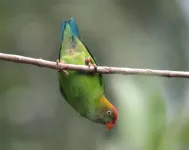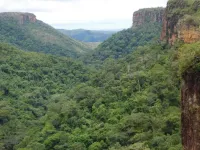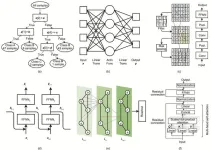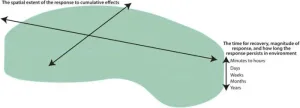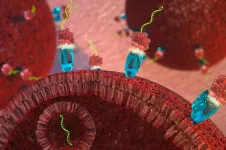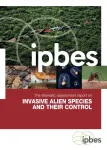(Press-News.org) It seems intuitive that forests would provide better habitat for forest-dwelling wildlife than farms. Yet, in one of the longest-running studies of tropical wildlife populations in the world, Stanford researchers found that over 18 years, smaller farms with varying crop types – interspersed with patches or ribbons of forest – sustain many forest-dependent bird populations in Costa Rica, even as populations decline in forests.
In a paper published Sept. 4 in the Proceedings of the National Academy of Sciences, Nicholas Hendershot and colleagues compared trends in specific bird populations across three landscape types in Costa Rica: forests, diversified farms, and intensive agriculture. The steepest declines were found in forests, then in intensive agriculture (and the species succeeding in intensive agriculture were often invasive). But on diversified farms, a significant subset of bird species typically found in forests, including some of conservation concern, actually increased over time.
“Birds are kind of a proxy we use to track the health of ecosystems. And the birds we’re seeing today aren’t the same as we saw 18 to 20 years ago. This paper really documents this pattern,” said Hendershot, a postdoctoral fellow at the time of this research in Stanford’s Department of Biology in the School of Humanities and Sciences (H&S), the Stanford Center for Conservation Biology (CCB), and the Stanford-based Natural Capital Project (NatCap).
Food security at stake
While this research implies that diversified farming could be key for biodiversity, the relationship goes both ways: biodiversity is key for food security. In this case, that means having a variety of types of birds feeding on insects and helping to pollinate crops.
“Identity does seem to matter a lot for pest control and other ecosystem services birds provide. These species are not interchangeable,” said Hendershot.
“We need a constant stream of pollinators servicing farms. About three-quarters of the world’s crops require pollinators to some extent, and that 75% is our most nutritious food – think of all the vitamins and minerals packed into fruits, nuts, and veggies,” explained Gretchen Daily, faculty director of NatCap and CCB, Bing Professor of Environmental Science in H&S, and a senior author on the paper. “We need a constant stream of birds, bats, and other wildlife to help control pests: they suppress the vast majority naturally. And we need to start building flood protection, water purification, carbon storage, and many other vital benefits back into agricultural landscapes, way beyond what can be achieved in protected areas alone.”
Daily also noted that, in terms of food production, diversified farms are not necessarily lower yielding than intensive agriculture. “This is a recent assumption that is being overturned,” she said.
Beyond protected areas
It has become increasingly apparent around the world that while protected areas remain critical, they are too few and far between to provide the ecosystem services people and nature need to thrive. Working landscapes are crucial now for preserving biodiversity and its benefits. “People, including scientists, had the idea that farmland would not support a meaningful amount of biodiversity,” said Daily. In this case, not only are diversified farms themselves providing habitat, they connect otherwise fragmented forested areas.
Over time, Hendershot said, “I have moved away from the ‘fortress conservation’ model, which focused more on creating protected areas separate from human activities, and see more and more how much potential there is outside of forests. The forests are key – we need them, of course. But in addition to that, I’m always surprised by how important how you manage a farm is for biodiversity.”
“We believe the findings of our research are new to science, but in a sense, it merely confirms what Indigenous communities around the world have already known for a long time, which is that humans can and should have reciprocal relationships with the rest of the local ecological community they are part of,” said Tadashi Fukami, a professor of biology in H&S and of Earth system science in the Stanford Doerr School of Sustainability and a co-author of the paper.
Incentivizing farmers
In the 1980s and 90s, deforestation was occurring in Costa Rica at the fastest rate ever seen on a country scale. Then, they turned it around – becoming a renowned model of success. By setting up the world’s first countrywide payment for ecosystem services (PES) program, Costa Rica reversed this trend: today, forests cover almost 60% of its land, up from 40% in 1987.
The country currently aims to double the amount of protected forest in just a few years. In its existing PES program, any landowner can receive money for reforesting even small parts of their land. Now, the government is also working toward a new PES program to incentivize farmers to adopt best management practices.
This study will help inform Costa Rican policymakers in understanding the benefits provided over time by different farming practices. Said Daily, “We need to recognize the vital work many farmers are doing that supports biodiversity.”
Nicholas Hendershot was a postdoctoral researcher with the Center for Conservation Biology at Stanford and is now a forest ecologist with The Nature Conservancy-California. Gretchen Daily is also a senior fellow in the Stanford Woods Institute for the Environment. Other co-authors on the paper are Alejandra Echeverri, a senior scientist at the Natural Capital Project, Luke Frishkoff of the University of Texas at Arlington, and prominent Costa Rican ornithologist Jim Zook.
Hendershot’s work was supported by the Gerhard Casper and John P. Morgridge Stanford Graduate Fellowship, the OTS Emerging Challenges in Tropical Science Fellowship, and the Winslow Foundation. Funding for data collection from 1999-2017 was generously provided to Daily by the LuEsther T. Mertz Charitable Trust, the Moore Family Foundation, and the Winslow Foundation.
END
Farms that create habitat key to food security and biodiversity
2023-09-04
ELSE PRESS RELEASES FROM THIS DATE:
The art of wandering in vertebrates: new mapping of neurons involved in locomotion
2023-09-04
For those fortunate enough to walk normally, wandering is such an expected behavior that we hardly consider that it involves complex, partly involuntary processes. “Animals move to explore their environment in search of food, interaction with others, or simply out of curiosity. But the perception of danger or a painful stimulus can also activate an automatic flight reflex”, Martin Carbo-Tano, a post-doctoral fellow at Paris Brain Institute, explains. In both cases, movement initiation relies on the activation of so-called reticulospinal control neurons, which form an intertwined network in ...
Most species are rare. But not very rare
2023-09-04
Halle/Saale, Fort Lauderdale. More than 100 years of observations in nature have revealed a universal pattern of species abundances: Most species are rare but not very rare, and only a few species are very common. These so-called global species abundance distributions have become fully unveiled for some well-monitored species groups, such as birds. For other species groups, such as insects, however, the veil remains partially unlifted. These are the findings of an international team of researchers led by the German Centre for Integrative Biodiversity Research (iDiv), the Martin Luther University Halle-Wittenberg ...
Extreme El Niño weather saw South America’s forest carbon sink switch off
2023-09-04
Extreme El Niño weather saw South America’s forest carbon sink switch off
Hot and dry conditions resulted in increased tree death
Evidence that most forest areas withstand periods of severe drought
Greatest impact in forests with drier climates
Tropical forests in South America lose their ability to absorb carbon from the atmosphere when conditions become exceptionally hot and dry, according to new research.
For a long time, tropical forests have acted as a carbon sink, taking more ...
Blowing snow contributes to Arctic warming
2023-09-04
When it comes to global warming trends, the Arctic is a troubling outlier. The Arctic warms nearly four times faster than the global average, and aerosols play an important role in that warming. Scientists have long known that pollutants from other regions can accumulate in the Arctic atmosphere where they alter atmospheric chemistry, absorb sunlight, and affect local weather patterns, leading to localized warming that melts ice and snow. Sea salt particles dominate aerosol mass concentration, but their production mechanisms and impact on Arctic climate have remained unclear.
Atmospheric scientists led by Jian Wang, director of the Center for Aerosol ...
Innovative solutions for chemical challenges: Harnessing the potential of machine learning
2023-09-04
In a review published in Engineering, scientists explore the burgeoning field of machine learning (ML) and its applications in chemistry. Titled “Machine Learning for Chemistry: Basics and Applications,” this comprehensive review aims to bridge the gap between chemists and modern ML algorithms, providing insights into the potential of ML in revolutionizing chemical research.
Over the past decade, ML and artificial intelligence (AI) have made remarkable strides, bringing us closer to the realization of intelligent machines. The advent of deep learning methods and enhanced data storage capabilities has played a pivotal role in this progress. ML has already demonstrated success ...
Uncovering thalassemia diversity in southern china through next-generation sequencing
2023-09-04
Around 5.2% of the global population carries abnormal hemoglobin genes [1]. Each year, 300,000 to 500,000 children are born with severe hemoglobinopathies worldwide, with approximately 80% of these cases occurring in developing countries [2]. Thalassemia is the most common hereditary hemoglobinopathy and occurs in 4.4 out of every 10,000 live births [3]. It is prevalent in Mediterranean coastal areas, Africa, the Middle East, Southeast Asia, and southern China.
A previous study indicated that Ganzhou, the southernmost city in Jiangxi province, had a thalassemia prevalence ...
NYU Abu Dhabi researchers develop novel tumor-targeting nanospheres with the potential to dramatically improve light-based cancer diagnosis and treatment
2023-09-04
Abu Dhabi, UAE (September 4, 2023) – In a breakthrough in cancer therapeutics, a team of researchers at the Magzoub Biophysics Lab at NYU Abu Dhabi (NYUAD) has made a significant advance in light-based therapies – biocompatible and biodegradable tumor-targeting nanospheres that combine tumor detection and monitoring with potent, light-triggered cancer therapy to dramatically increase the efficacy of existing light-based approaches.
Non-invasive, light-based therapies, photodynamic therapy (PDT) and photothermal therapy (PTT) have the potential to be safe and effective alternatives to conventional cancer treatments, which are beset by a ...
Ecosystem footprint concept and its potential applications in environmental management
2023-09-04
Traditionally, the impact of human activity on an ecosystem has lacked context when planning restorative ecosystem mitigation and management strategies. Multiple human activities over time and space, the resilience of a particular ecosystem, and the stress caused by many individual or related, overlapping activities that generate cumulative effects may affect the overall "ecosystem response footprint," or ability of an ecosystem to adapt and change to human activity.
A team of marine scientists reviewed the most recent perspectives on ecological footprints to rigorously define the term "ecosystem response footprint" as the ...
First-in-class targeted microRNA therapy slows cancer tumor growth
2023-09-04
WEST LAFAYETTE, Ind. – A new cancer therapy developed by Purdue University researchers attacks tumors by tricking cancer cells into absorbing a snippet of RNA that naturally blocks cell division. As reported today in Oncogene, tumors treated with the new therapy did not increase in size over the course of a 21-day study, while untreated tumors tripled in size over the same time period.
Cancer can begin almost anywhere in the human body. It is characterized by cells that divide uncontrollably and that may be able to ignore signals to ...
Invasive Alien Species Pose Major Global Threats to Nature, Economies, Food Security and Human Health: IPBES report
2023-09-04
The severe global threat posed by invasive alien species is underappreciated, underestimated, and often unacknowledged. According to a major new report by the Intergovernmental Platform on Biodiversity and Ecosystem Services (IPBES), more than 37,000 alien species have been introduced by many human activities to regions and biomes around the world. This conservative estimate is now rising at unprecedented rates. More than 3,500 of these are harmful invasive alien species – seriously threatening nature, nature’s contributions to people and good quality of life. Too often ignored until it is too late, invasive alien species are a ...

